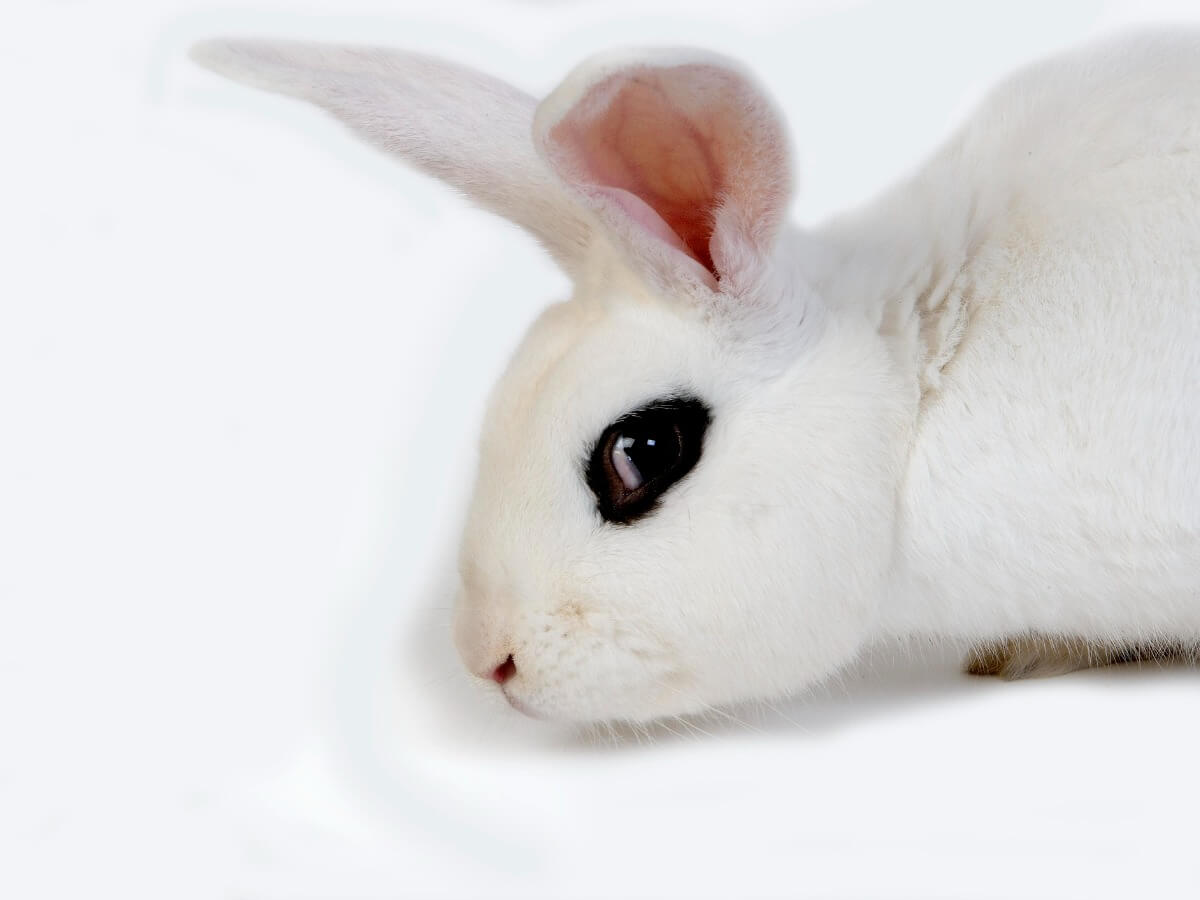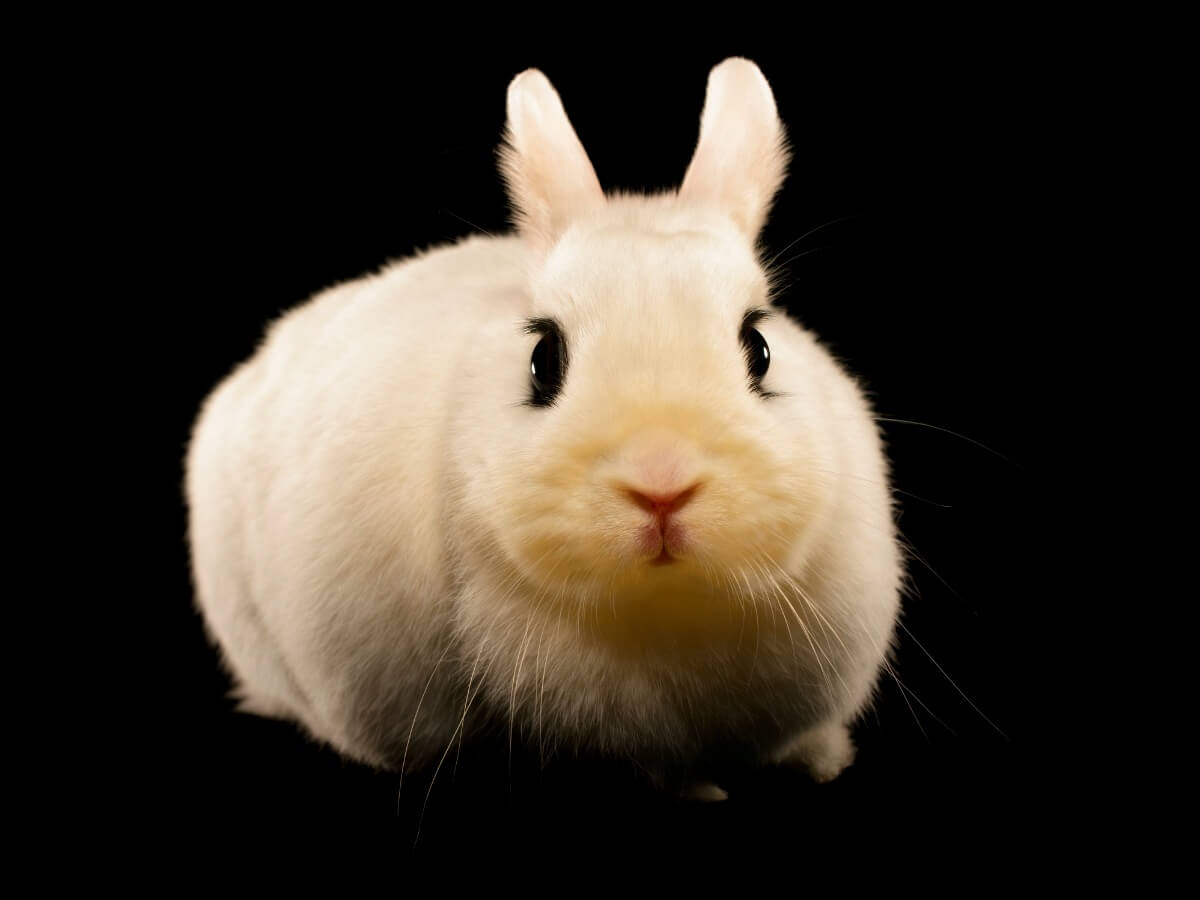The Blanc de Hotot Rabbit: Characteristics and Care


Reviewed and approved by the biologist Samuel Sanchez
Due to its affectionate nature and small size, the Blanc de Hotot rabbit has earned the appreciation of many. This animal emerged in France at the beginning of the 20th century and its first recognition as a breed took place in 1949, in the Netherlands.
However, despite being known beyond European borders, this rabbit is in danger of disappearing. We invite you to get to know all the characteristics that define it, as well as how to look after it in captivity.
Origin of the species
The breed comes from France, specifically from the Hotot-en-Auge region, hence its name. The first specimens emerged in 1902, after extensive work by breeder Eugenie Bernhard to get the rabbit with the characteristics that the Blanc de Hotot rabbit has today.
This animal shares genes with the White Vienna rabbit, the butterfly rabbit, or the Flemish giant. Because of its beauty, it quickly became popular and reached more countries around the world. However, World War II led to the near disappearance of the breed.
Already in the 60s and 70s, this rabbit was bred again and its population increased considerably. Even so, it wasn’t popular in countries like the US until several years later.
Unfortunately, breeding efforts aren’t enough at present, and the Blanc de Hotot rabbit is considered a potentially endangered species. Despite the fact that there are breeders who work to preserve the breed, there’s still a high risk of this breed disappearing.

Characteristics of the Blanc de Hotot rabbit
It’s a small animal, whose weight in males is somewhat higher than that of females – between 4.1 and 5 kilos for males and 3.6 and 4.5 kilos for females. Its fur is completely white, except for some characteristic black bands that border its dark brown eyes.
The width of these bands is part of the breed standard and, in adult specimens, they usually measure between 0.16 and 0.32 centimeters. It’s a trait that’s very reminiscent of the English spot rabbit and gives the animal the appearance of wearing black glasses.
In addition to the pristine white color of its coat (not counting the aforementioned eye bands), it should be noted that it’s quite dense, abundant, and smooth. On the other hand (and in relation to its body), it’s muscular and compact, despite being a small animal.
Blanc de Hotot character
This animal usually has a calm and affectionate character, but as experts remind us, the ideal thing is to socialize the rabbit as soon as possible. This means spending time getting it out of its cage and introducing it to children, adults other than its owners, and other animals.
Once they gain trust with the family, these mammals are quite funny and like to interact with their environment. For all these reasons, it’s a breed that’s highly appreciated as a pet by those who have the pleasure of having one of them.
The Blanc de Hotot rabbit is quite intelligent and shows a great predisposition when it comes to learning. Its obedience and ability to learn are really surprising, and this makes it quite easy to teach it some basic tricks, such as instructions or hygiene guidelines.
Caring for the Blanc de Hotot rabbit
As rabbits are somewhat prone to stress, one of the most important care aspects for the Blanc de Hotot rabbit will be its resting area. Because it isn’t excessively large, it doesn’t need too big a cage.
It’s best to opt for a minimum of 61 x 61 centimeters (24 x 24 inches), although of course, the wider the better. It must be remembered that within the facility there must be a place for their shelter and rest, an area where their food and drinking bowl can be located, and a corner with sand, so that the rabbit can relieve itself.
Even so, no matter how large the cage is chosen for this rabbit, it should always go out at least once or twice a day to be able to exercise. To do this, it is necessary to enable a room in the house free of obstacles and dangers (cover cracks and holes, hide cables, etc.).
After taking the appropriate measures, the rabbit will be allowed to explore the area freely, although with some supervision. These times should also be used by the owners to play with the rabbit and train it with tricks, always using positive reinforcement.
Extreme temperatures, both hot and cold, aren’t good for this animal, so the cage should always be placed in an area with warm temperatures. If you take the rabbit outside, you must bear the weather in mind.
Hygiene
A grooming brush should be used to comb the rabbit once or twice a week to remove surface dirt and dead hair. It must be remembered that it isn’t necessary to bathe the rabbit unless it’s a case of extreme dirt.
On the other hand, cutting the rabbit’s nails is another matter to consider, because if it doesn’t file them naturally, then the growth will end up disturbing the animal. In addition to this, its ears should be checked weekly to detect any problems, such as wax accumulation or ear mites.
Blanc de Hotot rabbit feeding
The main diet for this rabbit, as in the case of other breeds, is hay. In addition, you should always complete its diet with the correct proportion of fruits and vegetables, following the rule of 70% hay, 30% fruits, vegetables, and granules.
The Blanc de Hotot rabbit is a particularly sweet breed, which won’t refuse any food it’s attracted to. It’s important to keep this in mind so that you don’t exceed the recommended food intake for these rabbits. If you don’t then your rabbit could develop an obesity problem.
Blanc de Hotot rabbit health
The diseases that could affect this animal are the same as those of other rabbits. In general, the problems related to their oral health stand out, which end up affecting their health in general. This is so because, when the rabbit suffers from them, it doesn’t eat as it should because of the discomfort they cause.
Rabbit teeth don’t stop growing throughout their lives, so it’s essential that they wear them down when gnawing hay or specific toys for this purpose. Otherwise, malocclusion or tooth breakage may occur. If overgrowth has occurred or other types of problems are detected in its mouth (such as abscesses), you should go and see a vet.
In addition to this, we mustn’t forget that there are some deadly diseases for all rabbits and that, therefore, it’s important to administer the necessary vaccines that can protect them. The main illnesses to be prevented are viral hemorrhagic fever and myxomatosis.
In addition to the above, it should be remembered that rabbits tend to be very suspicious of humans. Excess affection (such as continued caresses or carrying them in your arms) can become quite stressful if a bond hasn’t yet been created.

However, if you take into account all the above and take proper care of your Blanc de Hotot rabbit, then it can become a great companion for around 12 to 14 years. If you give them the necessary attention, they’ll be your best friend for many years.
All cited sources were thoroughly reviewed by our team to ensure their quality, reliability, currency, and validity. The bibliography of this article was considered reliable and of academic or scientific accuracy.
- Blanc the Hotot Rabbit. Recogido el 10 de agosto en https://www.petguide.com/breeds/rabbit/blanc-de-hotot-rabbit/
- Las razas de conejo. Recogido el 10 de agosto en https://cunicultura.com/pdf-files/2010/4/5401-razas-las-razas-de-conejos.pdf
- Manual de conejos. Recogido el 10 de agosto en http://www.agrolalibertad.gob.pe/sites/default/files/crianza%20de%20conejos.pdf
- Zamira, T. R. M. Razas y manejo nutrimental de los conejos.
- Blanc de Hotot Rabbit. Recogido el 10 de agosto en https://petkeen.com/blanc-de-hotot-rabbit/
This text is provided for informational purposes only and does not replace consultation with a professional. If in doubt, consult your specialist.